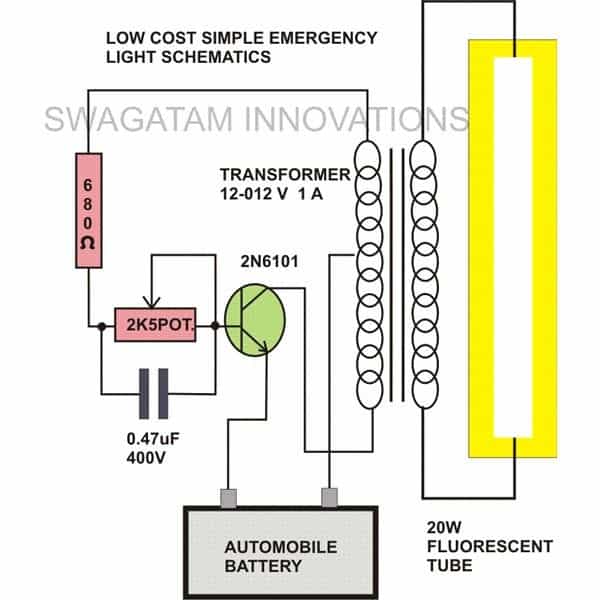This simple 20 watt home tube light circuit will work with any 12V battery and uses very few components yet is able to produce a reasonable amount of white light.
The components used are very common and can be easily procured from the local electronic retailer.
The idea is simple, the secondary winding of Tr1 and T1 along with the associated components forms a high frequency oscillator circuit.
How the Circuits Works
This oscillations forces an AC in the secondary winding of the transformer which is further induced into the primary of the transformer and stepped up to the corresponding rated value ofthe transformer.
The transformer used is an ordinary 12-0-12 volt 1Amp rated, it can be retrieved from any old, junk power supply unit that might be lying in your electronic junk box.
The transistor also is an ordinary type, here a 2N6101 is shown, but any other similar type will do. You may try a 2N3055 transistor or even a D1351 in place of the specified one.
The 2k5 preset is used for adjusting the frequency of the circuit which in turn affects the brightness of the connected tube.
The preset must be carefully optimized for obtaining maximum brightness on the tube and yet keeping the consumption on the relatively lower side.
The 0.47uF capacitor is also introduced for enhancing the output from the tube light, you may other nearby values for improving the overall brightness.
The battery can be a 12V, 7 AH battery which should last many hours.
However you cannot expect full striking brightness from this circuit. When I tested this circuit, I could never bring the tube light to its actual specified striking brightness.
The following diagram shows how to make a simple 20 watt fluorescent tube, 12V converter circuit.
Circuit Diagram Diagram

Parts List
- Resistors are 1/4 watt 5% CFR
- 680 Ω = 1
- Potentiometer 2.5 kΩ = 1
- PPC Capacitor 0.47 µF / 50 V = 1
- Transistor 2N6101 or any equivalent = 1
- Transformer 12-0-12 V / 1 A = 1
- Fluorescent Tube Light 20 Watt = 1
- Battery 12 V / 7 Ah = 1
Please I need an autocutoff battery charging circuit diagram that will charge 6v 4.5a battery for powering rechargeable lamp(not automatic but manually operated) which will not be draining battery when fully charged. I want to use it to build rechargeable led lamp. again how can I make my light to continue with full brightness for every long time like the commercial products from lontor.
You can try applying the following simple design
Thanks a lot for the simple and precise schematic diagram. Please how can I make brightness of the lamps last very long like the commercial alternatives. For instance Lontor rechargeable lamps that use 6v, 4.5ah lasts for more than 8hours with full brightness. I connected 20pieces of 5mm hi-efficiency white led of 20ma current and forward voltage of 3.6. in parallel.
Moses, Did you connect a resistor in series with each LED? If your LEDs are 3.3V and the supply source is 6V then either the LEDs will burn or they will consume huge amount of current.
So please connect a series resistor with each LED. The formula for calculating the resistor value is given below:
R = supply voltage – LED voltage / LED current.
connect the above resistor in series with each LED and then connect all the strings in parallel.
hi swag , can I use higher value of resistor in the place of 680 ohm. if yes how much will be maximum
Hi kulothungan, 1k is the maximum you should use.
Hi Sir, what is the wattage of the resistor? what other value can i use?
also the preset can i use 5k pot? also the polarity of the battery where to connect the positive (+ )?
Hi Amor, the resistor is 1/4 watt, yes 5K or 10K will also do for the preset. Positive of the battery will connect with the center tap of the transformer!
Hi Sir Swag, does a heatsink needed for the transistor 2n3055?
the fluorescent tube in my place has two pins in each side. thanks
Hi Amor, yes it is needed. You can short those pins or simply use anyone of them on each side….
Good evening sir!
can we get 40 watt flour.light by fitting two of these inverter circuit?if yes how to connect it each other?
you can do it simply by using a higher rated transformer, no need of two units.
but the illumination will be always half due to a half wave conduction in the trafo
Hi friend,
Thanks again for this circuit.
I want circuit so it will run 18w tube(2ft tube) with the power of 3v 2A or 6v 2A battery, i have small transformer 6-0-6 500ma , but i dont want to use big one..(like if 1A transformer bigger then 500ma), if any changes i can make from your above circuit so please tell me, or which parts i have to replace??? i will replace the parts from the circuit you showing above.
Thanks in advance….
Hi Kamlesh,
the above shown circuit is not very efficient and will not illuminate the tube with full brightness….you can try the following instead:
https://www.homemade-circuits.com/2014/11/12v-car-laptop-charger-circuit-using.html
Is preset necessary for this circuit?
it's for adjusting the brightness of the tube to the optimal point
what is preset??
variable resistor
sir,will this inverter charge the battery??
sir,will this inverter charge the battery?
No, it won't
no, i think it won't work with a mosfet